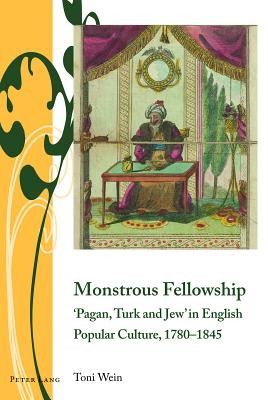
- We will send in 10–14 business days.
- Publisher: Peter Lang Ltd, International Academic Publishers
- ISBN-10: 1787078841
- ISBN-13: 9781787078840
- Format: 15.5 x 22.4 x 2.5 cm, hardcover
- Language: English
- SAVE -10% with code: EXTRA
Monstrous Fellowship (e-book) (used book) | bookbook.eu
Reviews
Description
This book brings together a range of texts and events: nineteenth-century novels and plays, riots on the streets and stages of London, popular games, artwork, criminal profiles and political economy. Tying these topics together is the spectacle created around «Pagan, Turk and Jew», a phrase appearing as early as 1548, and one that came to denominate fictional stand-ins for Irish Catholics, Muslims and Jews during the long nineteenth century.
Beginning with the Gordon riots of 1780, these «Others» were objectified as exotic bodies and used oppositionally against one another, both in policy and legislation and in cultural representations. Surveying literary works by Maria Edgeworth and Charles Dickens, as well as the work of lesser known figures such as Richard Cumberland, John Thomas Smith and Patrick Colquhoun, the author studies the role played by racial marking and ethnic stereotyping in the solidification of a post-riot British social body through both real and virtual spaces. Unlike other studies of minority experience and culture that concern a single population, this book casts a wider net, believing racist and religious bias to be a reactionary dynamic, prey to a host of struggles occurring simultaneously that ricochet off one another in the contestatory culture of the Romantic era.
EXTRA 10 % discount with code: EXTRA
The promotion ends in 20d.02:38:50
The discount code is valid when purchasing from 10 €. Discounts do not stack.
- Publisher: Peter Lang Ltd, International Academic Publishers
- ISBN-10: 1787078841
- ISBN-13: 9781787078840
- Format: 15.5 x 22.4 x 2.5 cm, hardcover
- Language: English English
This book brings together a range of texts and events: nineteenth-century novels and plays, riots on the streets and stages of London, popular games, artwork, criminal profiles and political economy. Tying these topics together is the spectacle created around «Pagan, Turk and Jew», a phrase appearing as early as 1548, and one that came to denominate fictional stand-ins for Irish Catholics, Muslims and Jews during the long nineteenth century.
Beginning with the Gordon riots of 1780, these «Others» were objectified as exotic bodies and used oppositionally against one another, both in policy and legislation and in cultural representations. Surveying literary works by Maria Edgeworth and Charles Dickens, as well as the work of lesser known figures such as Richard Cumberland, John Thomas Smith and Patrick Colquhoun, the author studies the role played by racial marking and ethnic stereotyping in the solidification of a post-riot British social body through both real and virtual spaces. Unlike other studies of minority experience and culture that concern a single population, this book casts a wider net, believing racist and religious bias to be a reactionary dynamic, prey to a host of struggles occurring simultaneously that ricochet off one another in the contestatory culture of the Romantic era.


Reviews